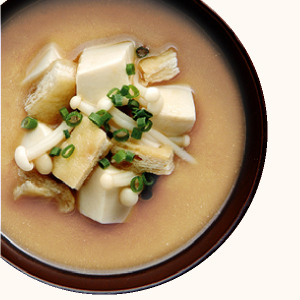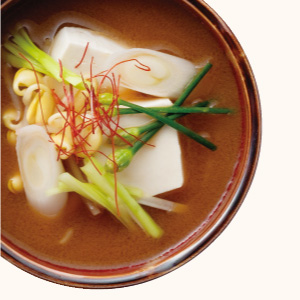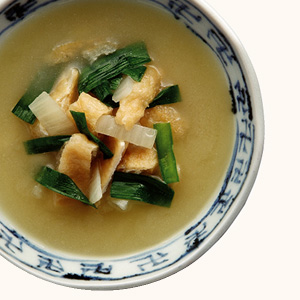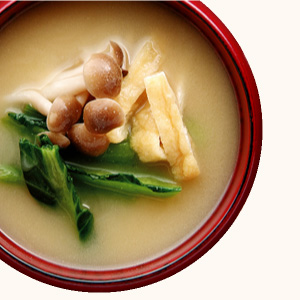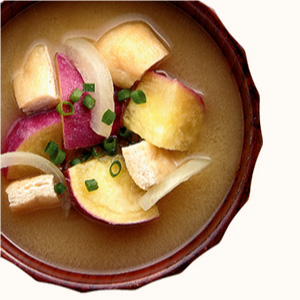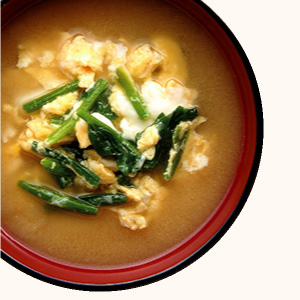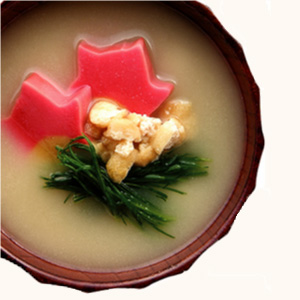
Tofu Miso Soup
About Tofu
Tofu miso soup is a typical miso soup. You can use tofu in miso soup together with many other ingredients. Since there are various types of tofu, you can choose different types of tofu according to your taste or to the ingredients to be used together.
Tofu Miso Soup Recipes
Tofu Miso Soups with Ingredients in Your Refrigerator
Try Something New! Uncommon Ingredients and Tastes
Miso Soups Using Special Tofu
Koyadofu (Freeze-dried Tofu)
Tamagodofu
(Steamed Egg Custard)
Yakidofu (Grilled Tofu)
Nutritional Difference Between Firm and Silken Tofu
Firm tofu (momendofu) is made by adding a coagulant, such as bittern, to soymilk and compressing it to solidify. It contains more iron, protein and calcium than silken tofu (kinudofu). On the other hand, it contains less vitamin Bs and potassium than silken tofu since water is squeezed out. These tofu are also different in texture. So, you can use them in your daily miso soups to your taste.
How to Store Tofu
A cake of tofu is often too much for miso soup for a meal. Place the remaining tofu in a container with enough water to cover tofu and store it in a refrigerator. Change the water everyday and use up the tofu in about 3 days at most before the expiration date.
Aburaage Miso Soup
About Aburaage
Aburaage is fluffy deep-fried tofu and absorbs various tastes easily. It is an excellent and almighty ingredient for miso soup. Its combination with popular vegetables, such as onions and bean sprouts, or vegetables in season, such as spring cabbage, makes miso soups savorier.
Before cooking, soak aburaage in boiling water for 1 ~ 2 minutes to remove oil. It reduces calories from aburaage and makes it absorb tastes more easily.
In the Osaka area, aburaage is known as “usage” rather than aburaage.
Aburaage Miso Soup Recipes
Aburaage Miso Soups with Popular Ingredients
Try Something New! Uncommon Ingredients and Tastes
Feast Miso Soups with an Arrangement
Nutrition of Aburaage
Aburaage is made by deep-frying thin tofu. Since it is made from soybeans, it contains plenty of nutrients, such as quality protein, carbohydrate, calcium and magnesium. In addition, it contains antiaging nutrients good for women, such as vitamin E, soy isoflavone and iron.
It also contains potassium. If you worry about the salt content of miso soup, potassium in aburaage helps your body to discharge salt, contributing to your health.
Kinds of Aburaage
There are many kinds of aburaage: Nankan-age in Kumamoto, Kyo-age in Kyoto, Matsuyama-age in Ehime, Yamato-age in Nara, sankaku aburaage in Miyagi, etc. Their shapes differ from region to region, and their thicknesses also differ. There is no standard form for aburaage.
Atsuage is often sold placed next to aburaage and also called “nama-age.” It is made by deep-frying thick tofu. Its inside is as soft as tofu while its surface is crispy, and you can enjoy different textures.
Nameko Miso Soup
About Nameko

Nameko mushrooms have a characteristic sliminess. They are convenient ingredients for making tasty miso soups. Although the season of natural mameko mushrooms is fall, most nameko mushrooms currently available on the market are artificially grown, and you can obtain them throughout the year. Since nameko mushrooms are easily spoiled, cook them soon after purchasing.
Nameko Miso Soup Recipes
Excellent Ingredients with Nameko
Nameko goes especially well with mild-taste ingredients, such as tofu, wakame, aburaage and daikon radish.
It can be combined with many ingredients, and you can try various ones.
Do I Need to Wash Nameko?
If nameko is fresh, you do not need to wash it. If nameko is a little old and has started to smell sour, you better wash it. But, wash it lightly since its sliminess is lost if you wash it too much.
The expiration date of nameko is often not printed on its package. As a rule, eat nameko within 3 days after purchasing.






